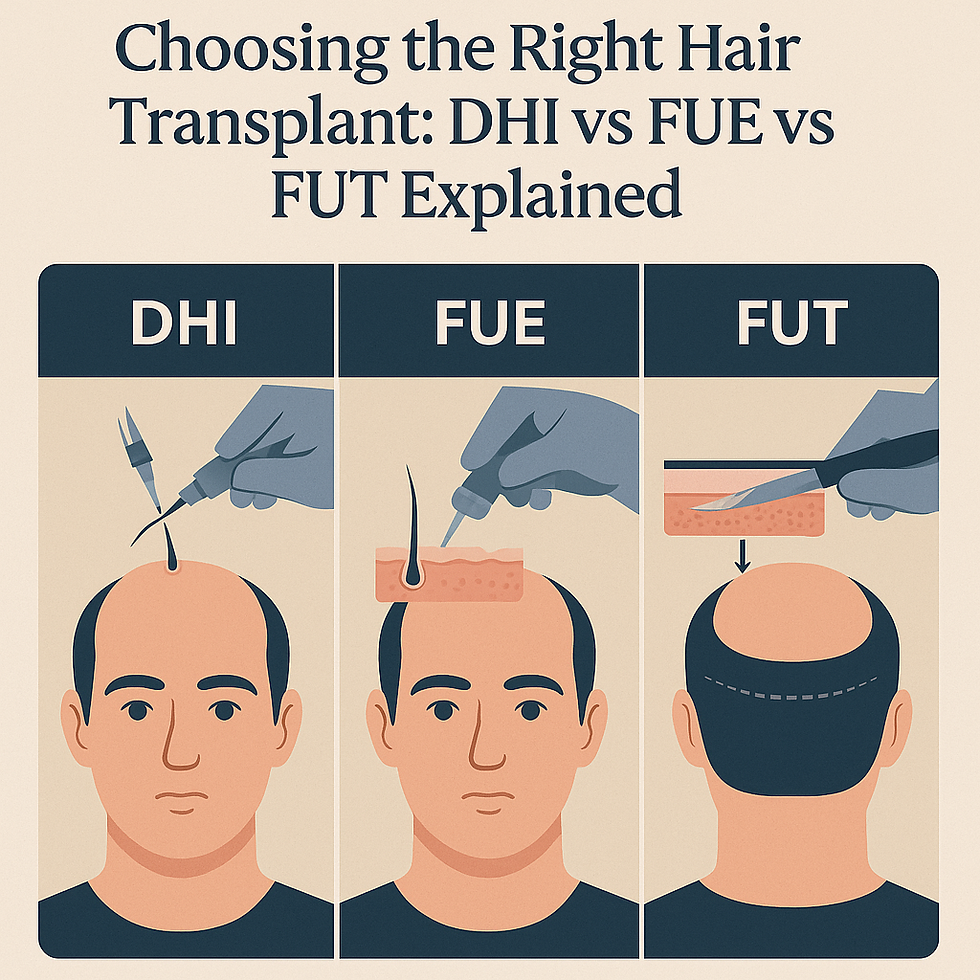Choosing the Right Hair Transplant: DHI vs FUE vs FUT Explained
- Vita Hair Clinic

- Jul 31, 2025
- 8 min read
Updated: Aug 4, 2025

When it comes to restoring hair, there are several techniques available such as DHI, FUE, and FUT. These methods provide options for individuals looking to achieve a fuller head of hair. Choosing the right technique is essential in order to achieve natural-looking results that meet your expectations.
Among the various hair transplant options, Direct Hair Implantation (DHI) has become a popular choice for those seeking the best outcomes and quickest recovery. This technique offers precise implantation and minimizes downtime, making it an attractive option for many.
In this article, we will explore the differences between DHI and two other commonly used methods: Follicular Unit Extraction (FUE) and Follicular Unit Transplantation (FUT). By understanding the strengths and weaknesses of each approach, you can make an informed decision about which one is right for you.
If you have any questions or need further information about our services, please feel free to contact us.
Understanding Hair Transplant Techniques DHI vs FUE vs FUT
In the world of hair transplant surgery, there are two main techniques that stand out: Follicular Unit Transplantation (FUT) and Follicular Unit Extraction (FUE). These methods differ in how they are performed, the results they produce, and their potential impact on patients. Let's take a closer look at each technique:
FUT Method
FUT involves removing a strip of skin from the donor area, usually the back of the head. This strip is then divided into individual follicular units for transplantation. While FUT can provide extensive hair coverage, it has a significant drawback - a linear scar where the strip was taken. This scarring can be a concern for patients who prefer shorter haircuts or like to keep their hair cropped close to the scalp.
FUE Technique
FUE, on the other hand, takes a more precise approach by extracting individual follicular units directly from the donor site using tiny punches. This method leaves small, dot-like scars that are less noticeable than the linear scar associated with FUT. Additionally, FUE offers a more natural appearance after transplantation due to the scattered arrangement of extracted follicles across the donor area.
Benefits of Individual Follicle Extraction with FUE
One of the key benefits of FUE is its accuracy in harvesting follicles, allowing for a targeted extraction process that minimizes damage to the surrounding tissues. Furthermore, FUE enables selective extraction of stronger and healthier follicles, resulting in potentially better survival rates after transplantation.
This method also provides flexibility in terms of hairstyle options post-surgery due to minimal scarring by understanding the differences between FUT and FUE techniques, individuals can make informed decisions about which approach aligns best with their aesthetic goals and lifestyle preferences.
Why DHI Stands Out as the Best Hair Transplant Technique
The DHI hair transplant technique has gained popularity for several reasons, making it stand out as a top choice for many individuals seeking effective hair restoration solutions:
1. Detailed Explanation of DHI Procedure
Direct Hair Implantation (DHI) involves extracting hair follicles one by one using a specialized tool and implanting them directly onto the recipient area without the need to create incisions beforehand. This innovative approach allows for precise placement of each follicle, resulting in natural-looking hair growth.
2. Precision in Determining Direction and Angle of Hair Growth
One of the key advantages of DHI over other techniques like FUE is its ability to control the angle and direction of implanted hair with great accuracy. This meticulous process ensures that the transplanted hair aligns seamlessly with the natural hair growth pattern, leading to a more aesthetically pleasing outcome.
3. Quick Recovery Time and Potentially Less Pain
DHI's minimally invasive nature contributes to a faster recovery period compared to traditional methods like FUT. Since DHI eliminates the need for creating recipient site incisions in advance, patients may experience reduced discomfort during and after the procedure. Additionally, the absence of visible scarring further enhances the appeal of DHI as a preferred hair transplant technique.
By prioritizing precision, natural results, and patient comfort, DHI has emerged as a leading option for individuals seeking long-lasting and satisfactory outcomes in their hair transplant journey.
Moreover, Turkey has become a leader in hair transplant, offering advanced techniques like DHI at affordable prices. This has led to a thriving medical tourism scene where individuals from around the globe flock to Turkey for their hair restoration needs. Whether it's a standard hair transplant or an Afro hair transplant, Turkey's expertise in this field is unmatched.
Choosing the Right Hair Transplant Technique for You
When it comes to choosing the right hair transplant technique, understanding your unique situation is essential. The decision between DHI, FUE, and FUT isn’t one-size-fits-all. Each technique offers distinct advantages that align differently depending on factors like the extent of your hair loss, your age, lifestyle, and personal goals.
Why Personalized Consultation Matters
A thorough consultation with experienced professionals helps tailor the treatment to your needs. Experts can assess:
Extent of Hair Loss: Whether you have minor thinning or extensive baldness influences which method suits you best. For example, FUT might be considered for larger areas but involves a linear scar. DHI and FUE are often preferred for smaller to moderate areas due to minimal scarring.
Age and Hair Characteristics: Younger patients may benefit from techniques that allow flexibility for future procedures as hair loss progresses. The quality and density of donor hair also impact which technique can yield optimal results.
Health and Scalp Condition: Certain scalp conditions or medical histories could affect healing or graft survival; these factors play a role in selecting the safest approach.
What Are Your Priorities?
Your expectations and lifestyle shape the choice further:
Natural Appearance: If your priority is achieving an undetectable, natural look with precise hair direction, DHI’s immediate implantation offers an edge.
Recovery Time: Those needing a faster return to daily activities might lean towards DHI or FUE over FUT because these methods typically involve less downtime.
Budget Considerations: While price shouldn’t be the sole deciding factor, knowing the cost differences among techniques is practical. Transparent clinics like Vita Estetic will discuss this openly without hidden fees.
Matching Technique to Desired Outcome
Reflect on what matters most in your hair restoration journey:
Longevity of Results – All three techniques can provide permanent results if performed correctly by skilled surgeons.
Scarring Concerns – FUT leaves a linear scar; FUE and DHI leave tiny dot scars that are generally unnoticeable even with short hairstyles.
Pain and Discomfort – DHI tends to cause less trauma during implantation, potentially reducing post-op discomfort.
Engaging with a trusted clinic where experienced doctors like Dr. Kinyas lead every step ensures you receive honest advice tailored specifically for you. This personalized approach allows you to confidently navigate DHI vs FUE vs FUT explained and select the method that aligns perfectly with both your current needs and future expectations.
However, it's also important to consider potential hair transplant side effects, which can vary depending on the chosen technique. Understanding these risks will further empower you in making an informed decision about your hair restoration journey.
Real Results: What to Expect After Your Hair Transplant Surgery
1. Post-Surgery Experience
After your hair transplant surgery, it's normal for the transplanted hair to fall out within the first few weeks. This shedding is a natural part of the process as the new follicles prepare to regrow. If you're wondering about the discomfort levels associated with the procedure, you can read more about it here.
2. New Growth Beginning
Following the shedding phase, you can expect to see new hair growth starting to emerge. Initially, this new growth may appear thin and sparse, but over time it will become denser and more natural-looking.
3. Timeline for Visible Results
The timeline for visible results after a hair transplant can vary from person to person. On average, most patients start to notice significant growth between 6 to 9 months post-procedure. However, full results may take up to a year to become apparent as the transplanted hair continues to thicken and blend seamlessly with your existing hair. It's important to have realistic expectations about the long-term outcomes of a hair transplant, which can provide insight into what you might expect years down the line.
By understanding the typical post-surgery experience and expected timeline for visible results, you can appreciate the gradual but transformative process of a successful hair transplant journey.
Conclusion
Choosing the best hair transplant technique is a deeply personal decision that depends on your unique needs, expectations, and lifestyle. The journey through DHI vs FUE vs FUT Explained has shown how each method has its own strengths and considerations. What really matters is placing your trust in a clinic that prioritizes honesty, patient care, and proven results.
At Vita Estetic, transparency isn’t just a buzzword — it’s the foundation of every consultation and procedure. You deserve clear information about:
The techniques suitable for you
Realistic outcomes based on your individual case
The complete treatment journey from start to finish
Every surgery is personally led by Dr. Kinyas, ensuring expert guidance throughout. His experience reflects in the clinic’s high satisfaction rates and natural-looking results that patients around the world appreciate.
Safety and comfort are not compromises here. With attentive aftercare, international-friendly services like airport pickup and translation assistance, you’re supported every step of the way. The goal is not just to restore hair but to rebuild confidence with integrity.
Remember, choosing a reputable clinic means choosing peace of mind alongside effective treatment. When considering your options for hair restoration abroad, weigh expertise and transparency as heavily as cost or convenience.
Your hair transplant journey should be empowering — informed by facts, personalized advice, and genuine care. Vita Estetic stands ready to guide you through this life-changing decision with clarity and compassion.
FAQs (Frequently Asked Questions)
What are the main differences between FUT, FUE, and DHI hair transplant techniques?
FUT involves removing a strip of scalp which may cause scarring, while FUE extracts individual follicles leading to less visible scars and a more natural look. DHI is an advanced form of FUE that offers greater precision by allowing immediate implantation of follicles with controlled direction and angle, resulting in better results and quicker recovery.
Why is DHI considered the best hair transplant technique compared to FUE and FUT?
DHI stands out due to its precision in implanting hair follicles directly without creating recipient site incisions beforehand. This allows for better control over hair growth direction and angle, faster recovery times, and potentially less pain compared to both FUE and FUT methods.
How do I choose the right hair transplant technique for my needs?
Choosing the right technique depends on factors like extent of hair loss, age, and desired outcomes. Consulting experienced professionals ensures personalized advice tailored to your individual needs, helping you select between DHI, FUE, or FUT for optimal results.
What should I expect during recovery after a hair transplant surgery?
Post-surgery, transplanted hairs typically shed within a few weeks before new growth begins. Visible results usually start appearing around six months post-procedure, with full effects noticeable up to a year later. Recovery experiences vary but DHI often offers quicker healing and less discomfort.
Are there any scarring concerns with different hair transplant methods?
FUT can result in linear scars due to strip removal from the scalp. FUE minimizes visible scarring by extracting individual follicles. DHI further reduces trauma by implanting follicles immediately without pre-made incisions, thus offering minimal scarring and a more natural appearance.
Why is it important to choose a reputable clinic like Vita Estetic for hair transplantation?
Trust and transparency are crucial when selecting a clinic. Vita Estetic, led by experienced professionals like Dr. Kinyas, ensures high standards of care, personalized treatment plans, and reliable outcomes using advanced techniques such as DHI for successful hair restoration.













.png)
Comments